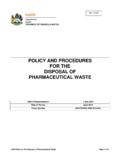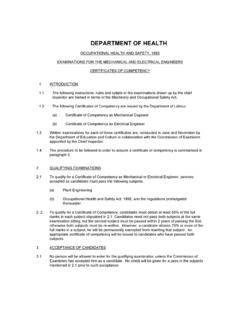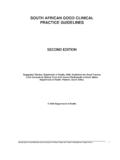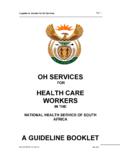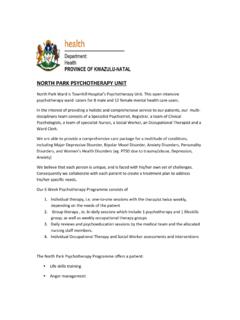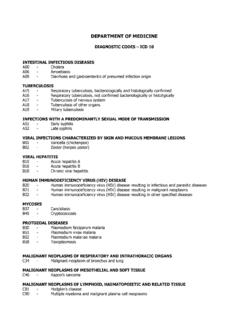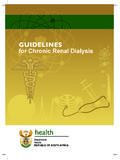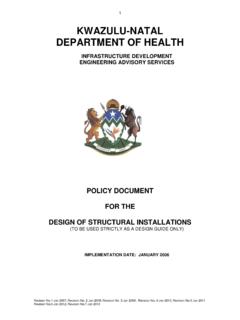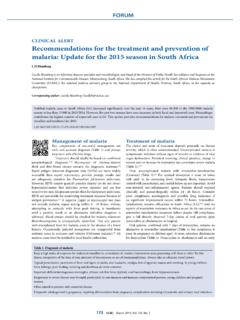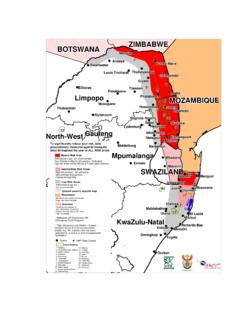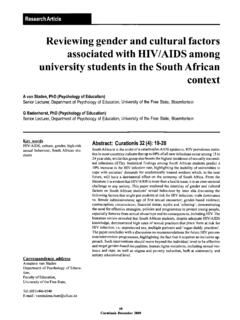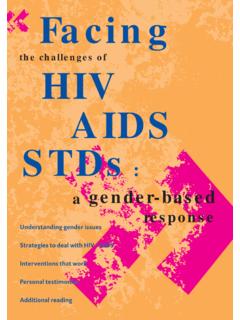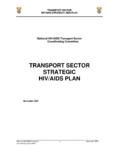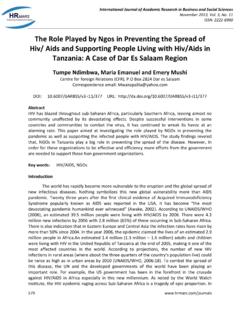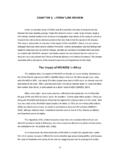Transcription of HIV/AIDS technical assistance guidelines
1 IDepartment of LabourPublished for the Chief Directorate of Labour RelationsPublisherDepartment of LabourChief Directorate of CommunicationPrivate Bag X117 Pretoria0001 South AfricaInternal editing, layout and design and distributionMedia Production UnitChief Directorate of CommunicationPrinterFormeset, Cape TownISBN No: 0-621-336566-4 HIV/AIDS technical assistance GuidelinesiiiiiForewordThis technical assistance guidelines (TAG) document is intended to complement the earlier adopted Code of GoodPractice on Key Aspects of HIV/AIDS and Employment of 2000 within the framework of the policy options indicated inthe Employment Equity Act of 1998.
2 The TAG will equip employers and other role players with practical tools toeliminate unfair discrimination based on HIV in the of the most serious public health problems facing South Africa is the HIV/AIDS epidemic. It not only threatens thelives of individual employees and employers, but has significant impact on each and every workplace, the effectivefunctioning of the labour market and the national economy as a impact of HIV/AIDS in the workplace is felt in many areas, for example the loss of productivity, increased cost ofemployee benefits, high production costs and lower workplace morale due to prolonged staff illness, increasedabsenteeism and mortality rates.
3 This, in turn, impacts negatively on the economy of the country as it slows downeconomic growth with less economically active persons able to contribute to the economy. The loss of an employeerequires an appropriate replacement to be selected and trained, which often is at great re-affirming the government s commitment to intensify its comprehensive programme to fight HIV/AIDS inpartnership with all sectors of society, my Department introduced specific provisions in the Employment Equity Act(1998), which specifically prohibit unfair discrimination on the grounds of an employee s HIV-status.
4 The Act alsoprohibits testing by employers without the prior authorisation by the Labour Court. To assist parties to understand andfulfil their obligations under the Act, particularly in respect of HIV/AIDS , the Code was developed, inter alia, to providestrategies to reduce the impact of the epidemic by developing policies and procedures to manage HIV/AIDS in theworkplace. To assist with the practical implementation of the Act and the Code, we developed the technical AssistanceGuidelines (TAG) on Key Aspects of HIV/AIDS and Employment. The TAG builds on the Code to set out practicalguidelines for employers, employees and trade unions on how to manage HIV/AIDS in the workplace.
5 It also serves asa guide to ensure that individuals affected by HIV/AIDS are not unfairly discriminated against in the workplace. Inessence, the TAG is based on the Department of Labour s broad goals in managing HIV/AIDS in the workplace, interalia, promotion of equality and openness around HIV/AIDS , creation of a balance between rights and responsibilities,and restoration of the dignity of persons affected by conclusion, I wish to express my sincere gratitude to the Commission for Employment Equity for the significant role itplayed in the development of the TAG.
6 I also take this opportunity to thank the Employment Equity Directorate forproviding support and technical assistance during the development of the special word of thanks go to the International Labour Organisation (ILO) and United Nations DevelopmentProgramme (UNDP) for their unwavering financial and technical support. MMS MDLADLANA, MPMINISTER OF LABOURT able of contentsPagesForewordiiiAcronyms and abbreviationsviGlossaryviiSummary of the contentsixChapter 11. Background to the Background to the Impact of HIV/AIDS in the workplace3 Chapter 22. Key legal and policy components of the Eliminating unfair discrimination and promoting a non-discriminatory Testing, confidentiality and Promoting a safe working Compensation for occupational Infection with Employee Dismissals and grievances32 Chapter 33.
7 Framework for managing HIV/AIDS in the Principles underlying a comprehensive response to Managing HIV/AIDS in the Implementation guidelines43 Appendix A: HIV/AIDS /Epidemic in perspective66 Basic facts on HIV/AIDS66 Key facts on HIV/AIDS in the workplace69ivGlobal and African review of HIV/AIDS statistics69 South African HIV/AIDS epidemic70 Impact of HIV on specific sectors70 Appendix B: Contact numbers of Department of Labour offices72vAcronyms and abbreviationsAIDSA cquired immune deficiency SyndromeASOsAIDS Service OrganisationsCCMAC ommission for Conciliation Mediation and ArbitrationCOIDAC ompensation for Occupational Injuries and Diseases ActDOHD epartment of HealthDOTSD irectly Observed Treatment Short-courseEAPE mployee assistance ProgrammeEEAE mployment Equity ActGIPAG reater involvement of people living with HIV/AIDSHIVH uman Immunodeficiency VirusILOI nternational Labour OrganisationKAPK nowledge.
8 Attitudes and PracticesLRAL abour Relations ActM&EMonitoring and EvaluationNEDLACN ational Economic Development and Labour CouncilNGONon Government OrganisationOHSO ccupational Health and SafetyPEPPost-exposure prophylaxisPLWAP erson living with HIV/AIDSPWAP erson with AIDSPMTCTP revention of Mother to Child TransmissionSADCS outhern African Development CommunitySANACS outh African National aids Council SANDFS outh African National Defence ForceSTDS exually Transmitted DiseaseSTIS exually Transmitted InfectionTBTuberculosisTMPsTraditional Medical PractitionersUNAIDSJ oint United Nations Programme on HIV/AIDSUNDPU nited Nations Development ProgrammeVCTV oluntary Counselling and TestingWHOW orld Health OrganisationviGlossaryAIDSA cquired immune deficiency syndrome - a syndrome that results from infection with HIVA ntibodiesSubstances produced by cells in the human body's immune system in response to foreignsubstances that have entered the bodyAsymptomaticInfected by a disease agent but exhibiting no medical symptomsCareSteps taken to promote a person s well being through medical, psychosocial.
9 Spiritual andother meansConfidentialityRight of every person, employee or job applicant to have their medical information,including HIV status, kept privateCounsellingCounselling is defined as a confidential dialogue between a client and a trainedcounsellor aimed at enabling the client to cope with stress and take personal decisionsrelated to HIV/AIDS . Counselling may be provided by a professional or a lay testEnzyme Linked Immuno-Sorbent Assay - the test used to identify the presence or absenceof HIV antibodiesEpidemicA disease, usually infectious, that spreads quickly through a populationEpidemiologyThe study of the distribution and determinants of disease in human populationsEvaluation An assessment of progress towards and the achievement of an objective.
10 Generallycarried out at a specific point, or points in time HIV testingAny form of testing designed to identify the HIV status of a person, including blood tests,saliva tests or medical questionnairesHIVH uman immunodeficiency virus - the name of the virus which weakens the immunesystem and leads to AIDSI mmune systemA complex system of cells and cell substances that protects the body from infection anddiseaseIncidence of HIVThe number of new cases of HIV in a given time period, often expressed as a percentageof the susceptible populationIndicatorA direct or indirect measure of changeMonitoringMonitoring is an ongoing assessment or measurement of a programme that aims toprovide early indications of progress, or lack of progress in the achievement of theprogramme s objectivesNetworks Individuals and organisations willing to assist one another or to collaborate to achievecommon goalsOccupational exposure Exposure to blood or other body fluids, which may be HIV infected.
